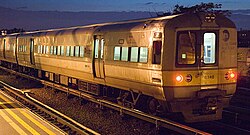M1A (railcar)
| M1/M3 | |
|---|---|

An M1 on the Long Island Rail Road at Jamaica in 2005.
|
|

The interior of an LIRR M3.
|
|
| Manufacturer | Budd Company |
| Built at | Red Lion Assembly Plant Northeast Philadelphia, PA |
| Family name | Budd Metropolitan |
| Constructed | M1/M1A: 1968-1973 M3/M3A: 1984-1986 |
| Entered service | M1: 1968-2007 M1A: 1971-2009 M3: 1985-present M3A: 1984-present |
| Number built | M1: 770 M1A: 178 Total M1: 948 M3: 174 M3A: 142 Total M3: 316 Total: 1264 |
| Formation | Married Pair |
| Fleet numbers | M1: 9001-9770 M1A: 8200-8377 M3: 9771-9944 M3A: 8000-8141 |
| Capacity | 120 (M3) |
| Operator(s) |
Long Island Rail Road Penn Central Conrail Metro-North Railroad |
| Specifications | |
| Car body construction | Stainless Steel, with fiberglass end caps on the operating ends |
| Train length | 170 ft (51.82 m) - 1,020 ft (310.90 m) |
| Car length | 85 ft (25.91 m) |
| Width | 10 ft 6 in (3,200 mm) |
| Height | 13 ft (3,962 mm) |
| Floor height | 4 ft (1,200 mm) |
| Platform height | 4 ft (1,200 mm) |
| Doors | Quarter point, double leaf automatic |
| Maximum speed | 100 mph (160 km/h) design 80 mph (130 km/h) service |
| Traction system | DC current fed through a camshaft controlled resistance switch to 4 DC traction motors. |
| Traction motors | M1/M1A: 4x148 horsepower (110 kW) GE 1255 A2 M3/M3A: 4x160 horsepower (120 kW) GE 1261(M3) |
| Power output | M1/M1A: 592 horsepower (441 kW) M3/M3A: 640 horsepower (480 kW) |
| Transmission | Electric |
| Train heating | electric heat, air conditioning |
| Electric system(s) | 650 V DC - 750 V DC Third Rail |
| Current collection method | Contact shoe |
| Bogies | M1: Budd Pioneer M3: General Steel GSI 70 |
| Braking system(s) | Pneumatic, dynamic |
| Safety system(s) | Cab signals with Automatic Train Control. emergency brakes |
| Coupling system | WABCO Model N-2 |
| Headlight type | Halogen light bulbs |
| Track gauge | 4 ft 8 1⁄2 in (1,435 mm) |
The M1 and M3 are two similar series of electric multiple unit rail cars built by the Budd Company for the Long Island Rail Road, the Metro-North Railroad and Metro-North's predecessors, Penn Central and Conrail. Originally branded by Budd as Metropolitans, the cars are more popularly known under their model names, M1 (late 1960s/early 1970s cars) and M3 (mid 1980s cars). The proper name for the Metro North series are the M1A and M3A respectively though they are colloquially called by the main LIRR designations for the sake of simplicity.
Even though the LIRR's fleet of some 900 MP54 electric MU cars constructed between 1908 and 1930 had been augmented between 1955-1963 by about 150 newer MP72 and MP75 EMU's, the roster still contained a large number of increasingly elderly prewar cars which the cash strapped LIRR was unable to replace. In 1965 the nearly bankrupt commuter railroad was taken over by the state owned Metropolitan Commuter Transportation Authority, later renamed the Metropolitan Transportation Authority in 1968, which was then able to provide large amounts of capital funding to bring the system to a state of good repair. One of the first items on the list was a massive order of brand new self-propelled electric railcars that could replace the remaining MP54's and provide modern levels of comfort and performance.
The Metropolitans, at the time of their introduction, were notable for their rounded ends and quarter-point sliding doors. The cars were fully air conditioned, accommodated only high level boarding, used light weight construction and were built with a top speed of 100 mph and support for Automatic Train Operation. The Metropolitan cars were also the catalyst of change for their respective systems as the high-level boarding required all stations in the electrified zone to be rebuilt from 1966-1968 and the increased power demand forced the LIRR to update its third rail power supply from 650 V DC to 750 V DC to take advantage of the cars' performance. On December 30, 1968 the M1's went into revenue service, with the first revenue train being an 8-car local from Babylon to Penn Station.
...
Wikipedia
